
The Goalkeeper CIWS is a Dutch close-in weapon system (CIWS) introduced in 1979. It is an autonomous and completely automatic weapon system for short-range defence of ships against highly maneuverable missiles, aircraft and fast-maneuvering surface vessels. Once activated the system automatically undertakes the entire air defence process from surveillance and detection to destruction, including the selection of the next priority target.

The Halifax-class frigate, also referred to as the City class, is a class of multi-role patrol frigates that have served the Royal Canadian Navy since 1992. The class is the outcome of the Canadian Patrol Frigate Project, which dates to the mid-1970s. HMCS Halifax was the first of an eventual twelve Canadian-designed and Canadian-built vessels which combine traditional anti-submarine capabilities with systems to deal with surface and air threats as well. All ships of the class are named after the capital cities most of the Canadian provinces plus the capital of Canada, Ottawa as well as the major cities of Calgary, Montreal, and Vancouver.
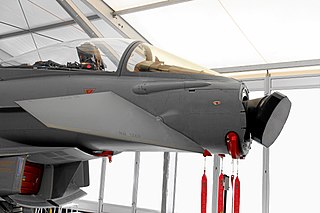
An active electronically scanned array (AESA) is a type of phased array antenna, which is a computer-controlled antenna array in which the beam of radio waves can be electronically steered to point in different directions without moving the antenna. In the AESA, each antenna element is connected to a small solid-state transmit/receive module (TRM) under the control of a computer, which performs the functions of a transmitter and/or receiver for the antenna. This contrasts with a passive electronically scanned array (PESA), in which all the antenna elements are connected to a single transmitter and/or receiver through phase shifters under the control of the computer. AESA's main use is in radar, and these are known as active phased array radar (APAR).
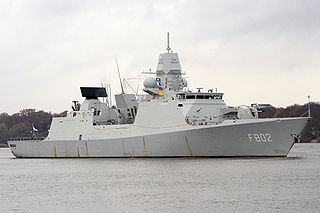
HNLMS De Zeven Provinciën (F802) is the first ship of the De Zeven Provinciën-class air defence and command frigates in service with the Royal Netherlands Navy (RNLN). There are three other ships in this class, HNLMS Tromp, HNLMS De Ruyter, and HNLMS Evertsen. De Zeven Provinciën is the eighth ship in the Royal Netherlands Navy to carry this name. The name refers to the original seven Dutch provinces which together formed the Union of Utrecht.

An infrared search and track (IRST) system is a method for detecting and tracking objects which give off infrared radiation, such as the infrared signatures of jet aircraft and helicopters.
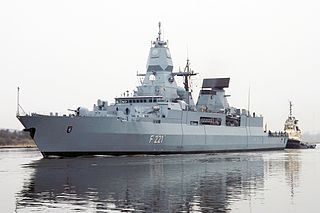
The F124 Sachsen class is the German Navy's latest class of highly advanced air-defense frigates. The design of the Sachsen-class frigate is based on that of the F123 Brandenburg class but with enhanced stealth features designed to deceive an opponent's radar and acoustic sensors. The class incorporates an advanced multifunction radar APAR and a SMART-L long-range radar which is purported to be capable of detecting stealth aircraft and stealth missiles.
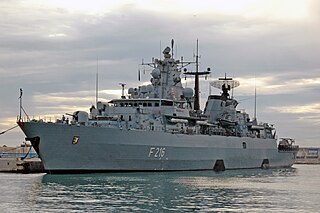
The F123 Brandenburg class is a class of German frigate. They were ordered by the German Navy in June 1989 and completed and commissioned between 1994 and 1996, replacing the Hamburg-class destroyers. The ships primarily carry out anti-submarine warfare (ASW), but they also contribute to local anti-aircraft defenses, the tactical command of squadrons, and surface-to-surface warfare operations. Together with the F124 Sachsen-class frigates, they are the mainstay of the German surface fleet.

The four De Zeven Provinciën-class frigates are air-defence and command frigates in service with the Royal Netherlands Navy. This class of ships is also known as "LCF". The ships are similar to the German Sachsen-class frigates in role and mission.
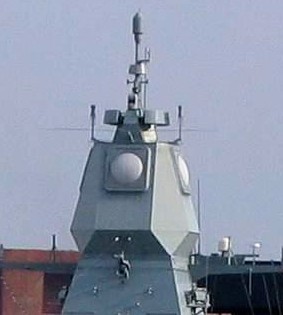
Active Phased Array Radar (APAR) is a shipborne active electronically scanned array multifunction 3D radar (MFR) developed and manufactured by Thales Nederland. The radar receiver modules are developed and built in the US by the Sanmina Corporation.
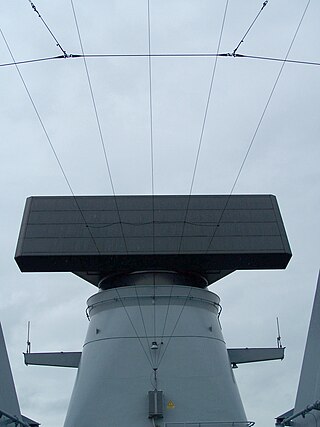
SMART-L is a long-range naval search radar introduced in 2002 by Thales Nederland, formerly Hollandse Signaalapparaten (Signaal).

The S1850M is a long-range radar with a digital antenna array for wide area search in elevation. The S1850M is manufactured by Thales and BAE Systems Integrated System Technologies. It is a modified version of the Thales Nederland SMART-L radar. The S1850M is advertised as being capable of fully automatic detection, track initiation, and tracking of up to 1,000 targets at a range of 400 kilometres (250 mi). It is also claimed to be highly capable of detecting stealth targets, and able to detect and track outer atmosphere objects at short range, enabling it to form part of a Theatre Ballistic Missile Defence system.
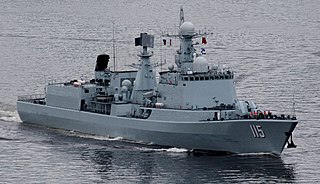
The Type 051C destroyer is a long-range air-defence guided-missile destroyer built by China in its ongoing effort to create a true blue water navy. The ship uses the hull design of the older Type 051B, but is equipped with the advanced Russian S-300FM air defence missiles systems. Currently, two ships of this class have been launched and deployed by People's Liberation Army Navy North Sea Fleet.
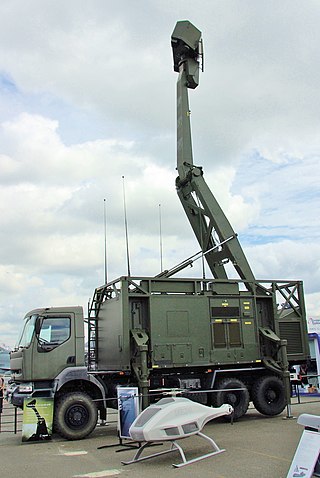
The Saab Giraffe Radar is a family of land and naval two- or three-dimensional G/H-band passive electronically scanned array radar-based surveillance and air defense command and control systems. It is tailored for operations with medium- and Short Range Air Defense (SHORAD) missile or gun systems, or for use as gap-fillers in a larger air defense system.

The Iver Huitfeldt class is a three-ship class of air defence frigates that entered service with the Royal Danish Navy in 2012 and 2013.

The AN/SPY-1 is a United States Navy 3D radar system manufactured by Lockheed Martin. The array is a passive electronically scanned system and a key component of the Aegis Combat System. The system is computer controlled and uses four complementary antennas to provide 360-degree coverage. The system was first installed in 1973 on USS Norton Sound and entered active service in 1983 as the SPY-1A on USS Ticonderoga. The -1A was installed on ships up to CG-58, with the -1B upgrade first installed on USS Princeton in 1986. The upgraded -1B(V) was retrofitted to existing ships from CG-59 up to the last, USS Port Royal.

SMART-S Mk2(Signaal Multibeam Acquisition Radar for Tracking, S band Mk2) is a naval medium to long-range air and surface surveillance multibeam passive electronically scanned array 3D radar designed by Thales Nederland, formerly Hollandse Signaalapparaten (Signaal). While the original SMART-S radar was only produced in small numbers, SMART-S Mk2 is very successful. Only six years after its introduction, 30 systems were sold to navies all over the world. SMART-S Mk2 radar is equipped with transmitter/receiver (T/R) modules manufactured by Turkish defence company Aselsan. The radar transmitter/receiver (T/R) modules for the radar are purchased by Thales from Aselsan.
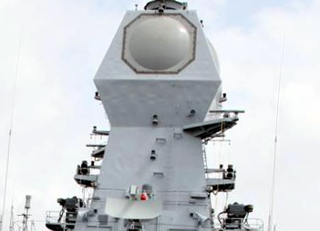
The EL/M-2248 MF-STAR is a multifunction active electronically scanned array naval radar system developed by IAI Elta for maritime installation on warships. It is capable of tracking both air and surface targets and providing fire control guidance. MF-STAR is an acronym of Multi-Function Surveillance, Track And Guidance Radar.

The Adhafer-class corvette is a type of stealth corvette belonging to the Algerian Navy. They are built in China by China State Shipbuilding Corporation CSSC in its Hudong-Zhonghua shipyard in Shanghai. The ship is 120 metres long and 14.4 metres wide and has a standard displacement of 2,880 tons. Three Adhafer-class ships were commissioned, with an option for three others of the same type. The first unit was launched on 15 August 2014 and commissioned in November 2015. The second and third were both commissioned in 2016.

ROKS Marado (LPH-6112) is the second ship of the Dokdo-class amphibious assault ship of the Republic of Korea Navy.

Mark 56 Gun Fire Control System is a gun fire-control system made up of AN/SPG-35 radar tracker and the Mark 42 ballistic computer.




















